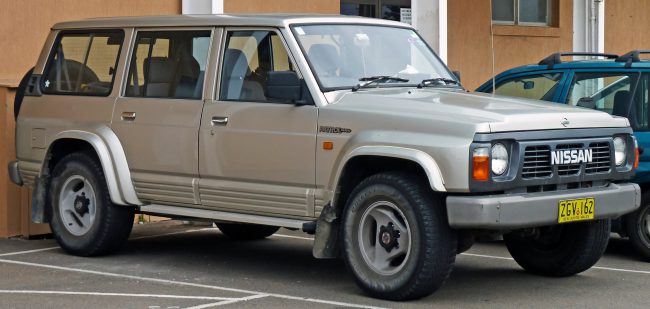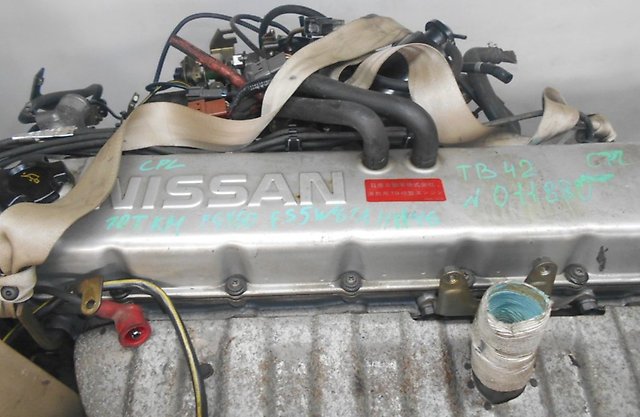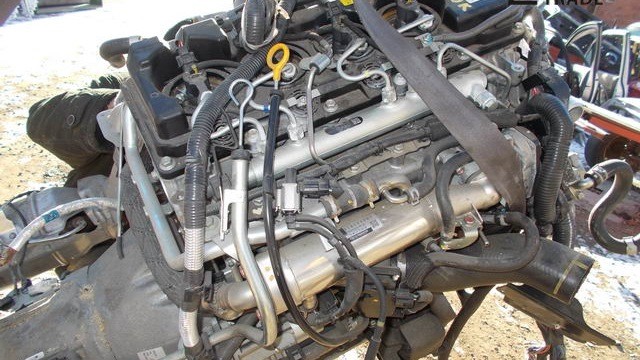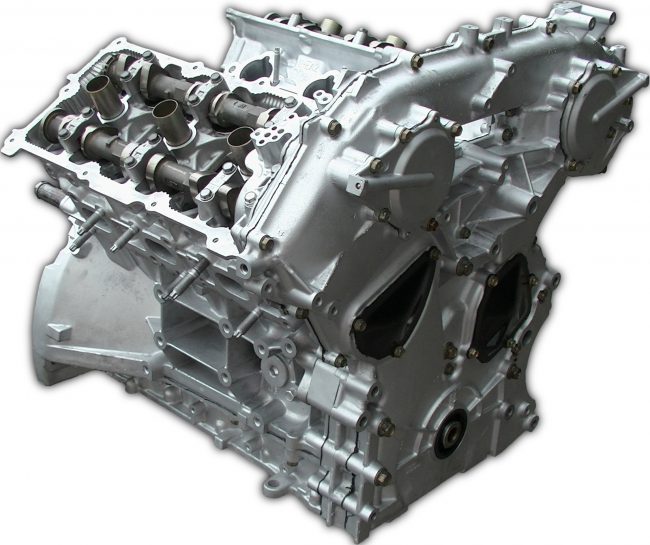
Nissan Patrol engines
Content
Nissan Patrol is a car widely known all over the world, which managed to win love and respect among those who like big cars with good cross-country ability during its very long production period.
It was first introduced in 1951 in two versions, the concept of which subsequently remained in subsequent generations: a short-wheelbase three-door and a full-wheelbase five-door frame SUV. Also, based on the full-base version, there were pickup and cargo versions (a class of light trucks on a frame).
In the period from 1988 to 1994 in Australia, the model was sold under the name Ford Maverick, in some European countries it was known as the Ebro Patrol, and in 1980 the most common name was the Nissan Safari. This car is now available for sale in Australia, Central and South America, in some countries of Southeast Asia and Western Europe, as well as in Iran and Central Asia, except for North America, where a modified version called the Nissan Armada has been sold since 2016.
In addition to civilian versions, a specialized line was also produced on the Y61 platform, which is common in Asia and the Middle East as a military vehicle, as well as a vehicle for special services. The newer Y62 platform was used extensively in the Irish Army.
First generation 4W60 (1951-1960)
By the year of production, many can guess that the world-famous Willis Jeep served as the basis for the creation. But this mainly concerns the appearance and ergonomics, while the engines that were installed on the 4W60 were somewhat different from the American ones. There were 4 engines in total, all in the "inline-six" configuration, gasoline. Quite serious tasks were set for the model: a civilian off-road vehicle, a military off-road vehicle, a pickup truck, a fire truck.
The classic 3.7L NAK engine used on the Nissan 290 bus at the time produced 75 hp. In addition to it, the following were also installed: 3.7 l NB, 4.0 NC and 4.0 P. NB - a modified engine in terms of power - 105 hp. at 3400 rpm and a torque of 264 N * m at 1600 rpm versus 206 for the previous one. Pretty good performance for 1955, right? In addition, the gearbox assumed the connection of a front-wheel drive.
The “P” series engines had similar characteristics and were installed accordingly when the model was updated. This series of internal combustion engines was updated and refined more than once, and its varieties were installed on Patrol until 2003.
Second generation 60 (1959-1980)
A rather serious change in appearance in this case, there were no major changes under the hood - there was a six-cylinder “P” 4.0l. Regarding this motor, some technical differences can be noted that allowed the Nissan Patrol not to change the power unit for as long as 10 years. Displacement 3956 cu. cm, hemispherical combustion chambers and a fully balanced seven-way crankshaft. Chain drive, carburetor and 12 valves (2 per cylinder), compression from 10.5 to 11.5 kg/cm2. Oil was usually used (and there are still models with this internal combustion engine) 5W-30, 5W-40, 10W-30, 10W-40.
Third generation 160 (1980-1989)
In 1980, this series was released to replace the model 60. The new series was supplied with 4 new engines, but the “P40” continued to be installed. The smallest 2.4L Z24 is a gasoline 4-cylinder ICE equipped with a throttle body injection system, also known as NAPS-Z (Nissan anti-pollution system).
A pair of L28 and L28E engines - are these gasoline powertrains? Different from each other by the fuel supply system. The L28 has a carburetor, and its modification has an injection system controlled by an ECU from Bosh, which is based on the L-Jetronic system. L28E is one of the first Japanese engines with such a system. Technically, even in this series, several more differences are implemented: pistons with a flat top, the compression ratio is increased and the power is raised from 133 to 143 hp.
 Diesel SD33 and SD33T have a volume of 3.2 liters. These are classic in-line diesel engines from Nissan, which are most famous in the layout of the Patrol 160 series, their power characteristics are not high, but the torque is sufficient for good cross-country ability and good speed development on the highway (100 - 120 km / h). The difference in power between these engines lies in the fact that the SD33T has a turbocharger, which is clear from the markings.
Diesel SD33 and SD33T have a volume of 3.2 liters. These are classic in-line diesel engines from Nissan, which are most famous in the layout of the Patrol 160 series, their power characteristics are not high, but the torque is sufficient for good cross-country ability and good speed development on the highway (100 - 120 km / h). The difference in power between these engines lies in the fact that the SD33T has a turbocharger, which is clear from the markings.
The third generation had a separate 260 series produced in Spain under the name Ebro. In addition to the Z24, L28, SD33, the Nissan Iberica plant installed a Spanish 2.7 l Perkins MD27 diesel engine complete with a locally produced gearbox to comply with Spanish law. They also installed 2.8 RD28 and its turbocharged version.
Fourth generation Y60 (1987-1997)
The Y60 series is already radically different from the previous ones in a number of mechanical improvements, such as: an increased level of interior comfort, a modified spring suspension that replaced the springs. Regarding the power units, there was also a complete update - to replace all previous engine models, 4 units of the RD, RB, TB and TD series were installed.
The RD28T is Nissan's traditional in-line six-cylinder, diesel-powered and turbocharged. 2 valves per cylinder, single camshaft (SOHC). The RB series is related to the RD, but these engines run on gasoline. Just like the RD, it is an in-line six-cylinder unit, the optimal range of which also lies beyond 4000 rpm. The power of the RB30S is higher than most of its predecessors in this car model, and the torque is at the same level. Marking "S" indicates the equipment with a carburetor as a mixture supply system. This engine was also installed in some modifications on the well-known Skyline.
 TB42S / TB42E - engines are larger l6 (4.2 l) and powerful, and since 1992 they have been equipped with an electronic injection system and electronic ignition. The configuration is such that the intake and exhaust gases are on opposite sides of the cylinder head. Initially, the fuel supply and the formation of the mixture were implemented using a two-chamber carburetor, and the current was supplied to the candles through a point distributor. The TD42 is a series of six-cylinder in-line diesel engines that have been installed on many models over the years, but the Y60 had the TD422. TD42 is a copy of a six-cylinder diesel engine with a prechamber. The cylinder head is similar to the TB42.
TB42S / TB42E - engines are larger l6 (4.2 l) and powerful, and since 1992 they have been equipped with an electronic injection system and electronic ignition. The configuration is such that the intake and exhaust gases are on opposite sides of the cylinder head. Initially, the fuel supply and the formation of the mixture were implemented using a two-chamber carburetor, and the current was supplied to the candles through a point distributor. The TD42 is a series of six-cylinder in-line diesel engines that have been installed on many models over the years, but the Y60 had the TD422. TD42 is a copy of a six-cylinder diesel engine with a prechamber. The cylinder head is similar to the TB42.
Fifth generation Y61 (1997-2013; still produced in some countries)
In December 1997, for the first time, this series became available in a configuration with 4.5, 4.8 liters of gasoline, 2.8, 3.0 and 4.2 liters of diesel internal combustion engines, alternative layouts with right and left hand drive for different countries, and for the first time options with an automatic gearbox were offered. .
The TB48DE is a six-cylinder in-line gasoline engine that already has some serious power and torque that is almost one and a half times higher than previous generations. Two camshafts and 4 valves per cylinder, with valve operation regulated by the Valve Timing Control system.
The TB45E is a revised unit that has had its cylinder bore increased from 96mm to 99.5mm with the same stroke. Electronic ignition and electronic injection system have improved performance and reduced fuel consumption.
The R28ETi comes in two variants that differ from each other in the amount of power that has been added to the RD28ETi with little loss of torque. Their technical equipment is identical: electronic control of the turbine, a heat exchanger for cooling the forced air flow.
 The ZD30DDTi is a XNUMX-litre, in-line, six-cylinder turbocharged unit with a heat exchanger. This diesel engine differs from its predecessor, like the others in this generation, with greatly increased power and torque due to the introduction of new electronic engine optimization systems.
The ZD30DDTi is a XNUMX-litre, in-line, six-cylinder turbocharged unit with a heat exchanger. This diesel engine differs from its predecessor, like the others in this generation, with greatly increased power and torque due to the introduction of new electronic engine optimization systems.
TD42T3 - improved TD422.
Sixth generation Y62 (2010-present)
The latest generation of the Nisan Patrol, also known as the Infiniti QX56 and Nissan Armada, is equipped with everything that many are used to seeing in modern cars. The technical equipment was reduced to the use of the three most powerful engines suitable for the heavy class of SUVs, namely: VK56VD V8, VK56DE V8 and VQ40DE V6.
The VK56VD and VK56DE are the largest engines currently in production for Nissan. V8 configuration, volume 5.6l is in the spirit of American automakers, who built it for the first time in Tennessee. The difference between these two engines is in power, which depends on the injection system (direct) and valve control (VVEL and CVTCS).
 The VQ40DE V6 is a slightly smaller 4 liter engine, equipped with lighter hollow camshafts and a variable length intake manifold. Multiple improvements and the use of modern materials have made it possible to greatly increase the power characteristics, as well as to use it in the layout of other car models that require such data for high-quality use.
The VQ40DE V6 is a slightly smaller 4 liter engine, equipped with lighter hollow camshafts and a variable length intake manifold. Multiple improvements and the use of modern materials have made it possible to greatly increase the power characteristics, as well as to use it in the layout of other car models that require such data for high-quality use.
Summary table of Nissan Patrol engines
| Engine | Power, hp/revs | Torque, N * m / Turnover | Years of installation |
|---|---|---|---|
| 3.7 NAK i6 | 75/3200 | 206/1600 | 1951-1955 |
| 3.7 NB I6 | 105/3400 | 264/1600 | 1955-1956 |
| 4.0 NC I6 | TBU | TBU | 1956-1959 |
| 4.0 .0 P I6 I6 | 125/3400 | 264/1600 | 1960-1980 |
| 2.4 Z24 l4 | 103/4800 | 182/2800 | 1983-1986 |
| 2.8 L28/L28E l6 | 120/~4000 | **** | 1980-1989 |
| 3.2 SD33 l6 (diesel) | 81/3600 | 237/1600 | 1980-1983 |
| 3.2 SD33T l6 (diesel) | 93/3600 | 237/1600 | 1983-1987 |
| 4.0 P40 l6 | 125/3400 | 264/1600 | 1980-1989 |
| 2.7 Perkins MD27 l4 (diesel) | TBU | **** | 1986-2002 |
| 2.8 RD28T I6-T (Diesel) | 113/4400 | 255/2400 | 1996-1997 |
| 3.0 RB30S I6 | 140/4800 | 224/3000 | 1986-1991 |
| 4.2 TB42S/TB42E I6 | 173/4200 | 32/3200 | 1987-1997 |
| 4.2 TD42 I6 (diesel) | 123/4000 | 273/2000 | 1987-2007 |
| 4.8 TB48DE I6 | 249/4800 | 420/3600 | 2001 |
| 2.8 RD28ETi I6 (Diesel) | 132/4000 | 287/2000 | 1997-1999 |
| 3.0 ZD30DDTi I4 (Diesel) | 170/3600 | 363/1800 | 1997 |
| 4.2 TD42T3 I6 (Diesel) | 157/3600 | 330/2200 | 1997-2002 |
| 4.5 TB45E I6 | 197/4400 | 348/3600 | 1997 |
| 5.6 VK56VD V8 | 400/4900 | 413/3600 | 2010 |
| 5.6 VK56DE V8 | 317/4900 | 385/3600 | 2010-2016 |
| 4.0 VQ40DE V6 | 275/5600 | 381/4000 | 2017 |

